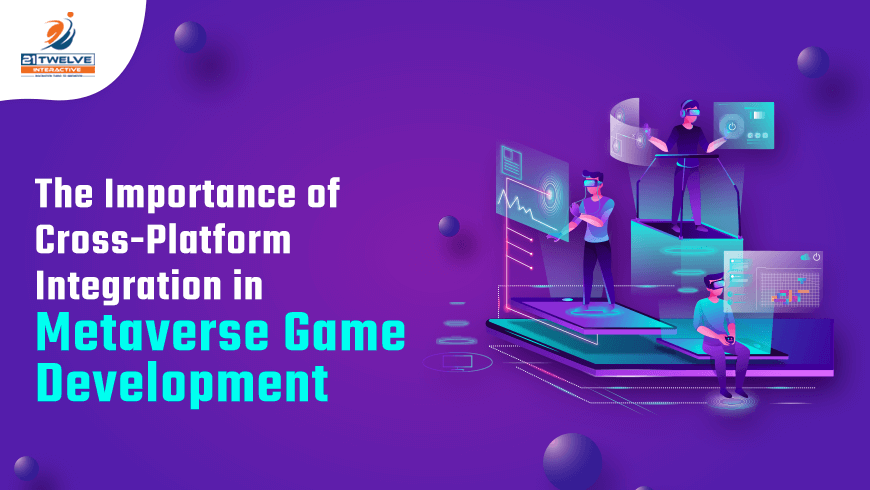
Metaverse is integrated into various industries, but the gaming industry is the main platform that uplifts the Metaverse space. These games make the user feel like they are present in Metaverse games. Undoubtedly, the Metaverse in gaming will bring the industry to new heights. The experience of feeling that you are really into the games is the reason for the success of Metaverse development. With this adding a cross-platform integration would give the best gaming experience.
Table of Contents
- What is Unity Metaverse?
- How does Metaverse boost the gaming industry?
- What is cross-platform integration?
- Benefits of cross-platform integration
- Creating cross-play Unity
- What is Metaverse interoperability?
- The component of Metaverse that can be made interoperable
- Possibilities awaiting in Metaverse gaming
What is Unity Metaverse?
Unity is a flexible program that allows several customizations while creating apps and other Metaverse games. It is a flexible technology with built-in functionality, cross-platform operability, access to the Unity asset store, and graphical elements. It is crucial for creating the next-generation ecosystems and Metaverse Apps.
Professional Unity developers create financially beneficial metaverse spaces with unity game development. By including elements like cross-chain interoperability, they also emphasize the emergence of a futuristic metaverse. Developers can ensure the correct smart contract event indexing and syncing are done using extremely sophisticated servers, dashboards, and APIs.
How does Metaverse boost the gaming industry?
The gaming business is already a billion-dollar industry with more than a billion users worldwide. As the Metaverse develops, millions of new users will enter the market, making it a trillion-dollar business sector.
Developing a Metaverse game involves building a virtual world while maintaining all of the gameplay elements within the storyline.
Game design is the first step in developing a Metaverse development. A Metaverse game’s storyboard is important. By describing the interactive narrative in the context of the world, you may draw in more players and their avatars.
What is cross-platform integration in game development?
Cross-platform game integration aims to create a game app that can be played simultaneously on several gaming platforms. The games are made using shared code and art assets using various techniques and tools by game creators. This will make Metaverse more easily accessible.
Cross-platform games are created by programmers using the whole development lifecycle.
The game is then simultaneously developed for various platforms and made available on various platforms. Building a cross-platform Metaverse game usually takes more time. But it may still be done far more quickly by making one version of the game and then remaking it to another platform.
Benefits of cross-platform integration:
You will reach more prospective players and influence the target audience most by creating metaverse gaming that can be played on various devices. A cross-platform game also helps in player management and ensures that the game maintains consistency across several marketplaces.
Overall, developing a game for many metaverse platforms directly is quicker than doing it after it has launched on one platform. A game is more likely to gain popularity quickly and draw in new players if compatible with more gaming platforms.
Some people enjoy playing games on a console, while others enjoy lounging on the couch or traveling. So, a cross-platform game will satisfy every player’s needs due to its greater accessibility. By creating a cross-platform game, gamers can pay for all launch expenses in a single cycle. Also, additional expenses won’t be required to reach new markets and audiences.
Despite the variety of platforms, the game has a single base code. It means that if an update is required, it can be released quickly. Hence, only one code base needs to be modified by the developers. There is no platform competition for sales in a cross-platform game. So, game advertising is more concentrated and targeted toward a certain group.
Creating cross-play Unity:
Without having to build and maintain their infrastructure, Unity’s game server’s hosting and scalable matching technology allow developers to offer the best experience to players. It is regardless of where they are or what platform they are using.
Hire Unity 3D Game Developer for seamless integration with cross-platform integration
Unity’s Metaverse development combines configurable match logic with an out-of-the-box interface with users to make matchmaking simple. It matches the right players quickly and at scale across all platforms.
The solution is flexible, dynamic, and scalable, enabling developers to connect the appropriate players at the right time and place. Provide the participants with feature-rich alternatives for secure and efficient communication with one another.
What is Metaverse interoperability?
Blockchain technology is a correct example to illustrate “interoperability” more simply. In the domain of blockchains, interoperable and non-interoperable blockchains both exist. Interoperability is necessary, but it disrupts the creation of creative and workable use cases.
Interoperability enables blockchain ecosystems to communicate, exchange data, and use one another’s features and services. Similarly to this, a Metaverse project with interoperability capabilities can communicate with another Metaverse project.
Their services and features enable cross-chain social networking and various other activities that are not in a segregated ecosystem. In other words, the way interoperability functions in the blockchain are the same as in the Metaverse development.
The component of Metaverse that can be made interoperable:
1. Avatars:
Interoperability enables avatars to freely switch between Metaverse projects and explore various facilities, just like people do in the real world.
2. Services and features:
Projects that interact in the Metaverse can use each other’s services and features. To execute a particular dApp on Metaverse, a project might use the smart contracts of another decentralized Metaverse project.
3. APIs:
There are numerous APIs for diverse Metaverse projects, each meeting certain requirements. You can use an external API from another Metaverse project.
4. Assets:
In the interoperable Metaverse development, avatars can move their possessions and things from one platform to another for various uses, such as gaming, trading, and integrating their new businesses. Gamers can switch between different Metaverse to take part in the gaming that is provided there.
5. Storage:
If the project permits it, interoperability can allow a Metaverse to access other Metaverse projects’ unused hard disc space. The additional storage will enable the decentralized network to store more files and data.
Possibilities awaiting in Metaverse gaming:
1. The platform for games goes beyond gaming:
A game development company can use this functionality to produce and integrate its content. By enabling players to create their content and use the gaming platform for other purposes, the Metaverse will increase the flexibility of gaming.
2. Social gaming:
Technically speaking, playing games in the Metaverse involves social interaction. The introduction of multiplayer games has given rise to chances in the Metaverse to ask your contacts to participate, engage with other players, and widen your social network.
3. Realistic virtual reality:
The Metaverse improves the digital experience using augmented and virtual reality games. Both 2D and 3D experiences are available to users. They can decide to live in that world if it appeals to them.
4. Portable digital assets:
The Metaverse is intended to function with other systems. So, consumers can transfer their digital assets between platforms. For instance, in-game items, weapons, accessories, and powers can be transferred to another game.
5. Earning while playing:
Play to Earn is considered to be an essential aspect of the Metaverse. You do more than make things and experiences; you can also exchange them for other goods if the platform accepts them.
6. The future of Metaverse gaming:
The Metaverse will become easier to use, more immersive, and more accessible as technology develops. Gamers can produce new prospects, business models, and revenue streams through games in virtual reality.
It is important to pay attention to the Metaverse because it has the potential to transform how people live, work, and play. The gaming sector in the Metaverse will rapidly expand in the years to come because of its enormous potential.



